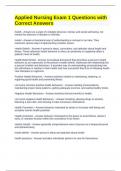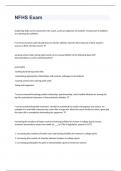Applied Nursing Exam 1 Questions with
Correct Answers
health - Answer-As a state of complete physical, mental, and social well-being, not
merely the absence of disease or infirmity.
model - Answer-a theoretical way of understanding a concept or an idea. They
represent various ways of approaching complex issues.
Health Beliefs - Answer-A person's ideas, convictions, and attitudes about health and
illness. These influence health behavior so they can positively or negatively affect a
patient's level of health.
Health Belief Model - Answer-Conceptual framework that describes a person's health
behavior as an expression of the person's health beliefs. Addresses the relationship b/n
a person's beliefs and behaviors. It provides way of understanding and predicting how
pts will behave in relation to their health and how successful they'll be in following health
care therapies or regimens.
Positive Health Behaviors - Answer-activities related to maintaining, attaining, or
regaining good health and preventing illness.
List some common positive health behaviors. - Answer-Getting immunizations,
maintaining proper sleep patterns, getting adequate exercise, and eating healthy foods.
Negative Health Behaviors - Answer-activities that are harmful to health.
List some negative health behaviors. - Answer-Smoking, abusing drugs or alcohol,
following a poor diet, and refusing to take necessary medications.
Health Promotion - Answer-behavior motivated by desire to increase well-being and
actualize human health potential
Health protection - Answer-behavior motivated by the desire to avoid illness, detect it
early, or maintain function within the constraints of an illness
Holistic Health - Answer-generally comprehensive view of person as a biopsychosocial
and spiritual being
health beliefs - Answer-person's ideas and attitudes about health
health practices - Answer-activities individuals perform to care for themselves
,Passive strategies of health promotion - Answer-where individuals gain from the
activities of others without acting themselves
active strategies of health promotion - Answer-individuals adopt specific health
programs
health promotion - Answer-activities that help patients maintain of enhance their present
levels of health and reduce risks for developing certain diseases
wellness education - Answer-teaches people how to care for themselves in a healthy
way
illness prevention - Answer-activities that protect patients from actual or potential threats
to health
primary prevention - Answer-True prevention. Precedes disease or dysfunction. Applies
to patients considered physically and emotionally healthy. Purpose it to decrease
vulnerability of individual or population to illness or dysfunction. Includes passive and
active strategies of health promotion.
Describe secondary prevention - Answer-Focuses on people who are experiencing
health problems or illness and who are at risk for developing complications or worsening
conditions. Directs activities at diagnosis and prompt intervention, thereby reducing
severity and enabling patients to return to normal level of health as early as possible.
Includes screening techniques and treating early stages of disease.
Describe tertiary prevention - Answer-occurs when defect or disability is permanent,
irreversible, and stabilized. Involves minimizing effects of long-term disease or disability
by interventions directed at preventing complications and deterioration. Activities are for
rehab rather than diagnosis and treatment.
Risk Factor - Answer-any situation, habit, environmental condition, physiological
condition, or other variable that increases vulnerability of an individual or a group to an
illness or accident.
illness - Answer-state in which a person's physical, emotional, intellectual, social,
developmental, or spiritual functioning is diminished or impaired compared with previous
experience.
acute illness - Answer-usually short term and severe. Symptoms appear abruptly, are
intense, and often subside after relatively short period.
chronic illness - Answer-usually lasts longer than 6 months. Patients fluctuate between
maximal functioning and serious health relapses
illness behaviors - Answer-how people behave when they're sick
, levels of health care - Answer-preventive, primary, secondary, tertiary, restorative, and
continuing care
preventive care - Answer-blood pressure and cancer screening, immunizations, poison
control information, mental health counseling and crisis prevention, and community
legislation (seat belts, air bags)
Primary care - Answer-"health promotion" like prenatal care, well-baby care, nutrition
counseling, family planning, exercise classes
secondary care - Answer-emergency care, acute medical-surgical care, and radiological
procedures
tertiary care - Answer-intensive care, psychiatric facilities
restorative care - Answer-cardiovascular and pulmonary rehab, sports medicine, spinal
cord injury programs, and home care
continuing care - Answer-assisted living and psychiatric and older adult day care
autonomy - Answer-means that a person is reasonably independent and self-governing
in decision making and practice.
responsibility - Answer-refers to duties and activities that an individual is employed to
perform
authority - Answer-the official power to act in areas in which and individual has been
given and accepts responsibility
accountability - Answer-liability or individuals being answerable for their actions
staff involvement - Answer-all staff members actively participate in unit activities
list the five rights of delegation - Answer-right task, right circumstances, right person,
right direction/communication, and right supervision
Common laws - Answer-laws based on judicial decisions or case law precedent
statutory laws - Answer-rules codified by legislative bodies of government
Nurse practice acts - Answer-statutes enacted by state legislatures to regulate the
practice of nursing. These acts of each state define the scope of nursing practice and
expanded nursing roles, set educational requirements for nurses, and distinguish
between nursing practice and medical practice.





